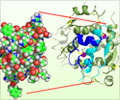Levels of certain proteins found in blood are associated with a reduced risk for developing type 2 diabetes, say Albert Einstein College of Medicine researchers.

Researchers have hypothesized that the IGF axis may influence risk for developing diabetes – an idea supported by laboratory and mouse studies, and a few initial studies in humans. However, the current study is the first large, prospective investigation of several components of the IGF-axis and the risk for developing diabetes, according to co-senior author Howard Strickler, M.D., M.P.H., professor of >epidemiology & population health at Einstein.
In the current study, the researchers analyzed levels of IGF-1, IGFBP-1, IGFBP-2, and IGFBP-3 in blood taken from 742 women in the Nurses' Health Study who years later developed type 2 diabetes as well as a similar number of women in the study who did not develop diabetes. None of the women had any signs or symptoms of the disease at the time their blood samples were taken. The median time between the taking of blood samples and diabetes onset was nine years.
Each component of the IGF axis (IGF-1 and IGFBP-1, -2, and -3) had a significant independent association with diabetes risk – most notably IGFBP-1 and -2. Compared with women in the bottom 20 percent with respect to their levels of IGFBP-1, having high levels of IGFBP-1 (top 20 percent) was associated with a three-fold reduction in risk for diabetes, while high levels of IGFBP-2 were associated with a more than five-fold reduction in diabetes risk.
"Our data provide important new evidence that circulating IGF-axis proteins may have a role in the development of type 2 diabetes," said Dr. Strickler.
The findings have potential clinical implications. First of all, IGF-axis proteins could help in stratifying people at risk for diabetes. "For example," said Dr. Strickler, "we know that obesity is a major risk factor for diabetes. But some overweight individuals don't develop diabetes, while some thin people do. If our findings are confirmed, they could help doctors more precisely determine who is actually at risk for the disease."
Advertisement
Source-Eurekalert















